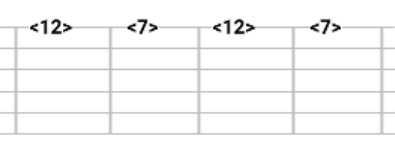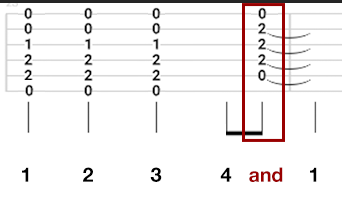Also, Neil Young’s “Heart of Gold” has some chord pushes.
I actually learned “The rhythm push” early on, without realizing it. I was watching a song tutorial towards the end of first week and they were talking about changing on ups… and how a lot of songs, esp faster paced, have the chord change begin on the & after 4… and even more if you listen will begin the chord change (so yes you’re strumming the bottom 3 strings open up on the and after 4… or whatever the last count would be before chord change)… it adds another dynamic. The person giving the song tutorial demonstrated a bunch of moderate to fast paced songs where he rapidly would hit the chords on one, still strumming the previous chord on the & after 4, with his hands perfectly in place for both… it became clear that the open string up strum sounded more… natural. It added another dynamic to the sound that also pushed the rhythm forward and made it more fluid…. Where I really learned changes (with fingers fully in place on the upstrums), was about 1.5-2 weeks ago learning the intro for “Weezer - Island In the Sun”… I spent like 6 hours slowly it down and gradually speeding up, stumbling, starting back slow etc… and by the end could play it perfectly… granted I’m pretty sure it’s a slightly simplified vs… I think the original actually is a muted upstrum on the change… have to listen to the original recording again… anyways, even without the muted strums, it’s a really awesome, fun song, where the pattern/progression used for the intro/interludes/solo incorporate all chord changes on upstrums and drive this really cool rhythmic “push”/effect. After spending the time and getting that part down, I’m finding when I encounter any chord changes on upstrums now, it’s normally easy and natural. If you haven’t though, and want a fun challenge with the chord changes on upstrums search YouTube for “weezer island in the sun guitar lesson”, and you’ll find a great one that will help you really hammer this technique home!
Not necessarily dropped - syncopation can prob be explained easiest by a rhythm/beat/stress/accent where it’s not expected, or normally wouldn’t be. This can absolutely include dropping though. Depends on the song… if I recall correctly, a lot of Ed Sheeran songs incorporate some form of syncopation. Esp full/not made easy versions. If you watch him live he does it a lot too. I recall learning about syncopation initially from a Sheeran song though… then seeing him live, it was really interesting to notice it… his playing style is very… rhythmic, and unique and while the chord progressions are normally fairly easy/common… he uses a bunch of techniques in the rhythm and pattern/strumming to make them unique and stand out… he does it with dynamics on some of his fingerpicked songs too… it’s really cool if you listen and watch out for it.
Can someone explain to me where the push occurs in Buffalo Springfield’s ‘For What It’s Worth’ - in the verse or the chorus, where in the rhythm count and with what chords? I’m not sure if I’m hearing it right and I’ve heard Justin mention this push twice so far with this song but he hasn’t said where in the song the push occurs. Thanks in advance!
FWIW (ha!) I just played the entire song in the Songs App, and don’t hear or see any chord pushes indicated.
I haven’t checked the app so I don’t know it that has a simplified version.
In the original version, you can hear the rhythm push in the intro and verses, when switching from the E to the A chord. It’s quite subtle though, so you’ll have to listen very carefully. I wouldn’t even worry about it in the beginner’s stage, focus on changing the chords on beat 1. But here’s what’s going on:
- The harmonics are always on beat 1.

- The push happens on the ‘and’ after four. You can hear the change just before the harmonic. The image shows a simplified strumming pattern.

I just listened to the original, and believe you are correct. But as you say, it is quite subtle I don’t think I would’ve picked up on it without you pointing to it.
I am a little surprised that the app version does not incorporate this. I’ve seen many many other songs that to show the pushes.
I always check the app first for things like pushes. The way the app superimposes chord changes over the beats and offbeats makes pushes very obvious visually. You can then slow the song down and play along till you get it right.
But not this time… ![]()
Another great lesson - I also use this strumming pattern to help me with chord changes I dont feel comfortable with. I will do PFC but still feel like I cant switch quick enough and this helps force my fingers to move.
Hello!
I am wondering if it is necessary have to counting the rythm (1+2+3+4+)? It is much more difficult! I can’t remember what Justin said about the counting. Is it necessary? If it is important, i will do it.
Thanks!
I did not find counting helpful for rhythm pushes.
For me, it was more important to focus on changing pushed chords on the upstrum.
That D to G push change reminds me of a song but I can’t remember which song.
Akshay,
It reminds me of Tom Petty’s “I won’t back down”.
Justin has a lesson on that song:
Tod
I learned Ablaze by Alanis Morissette for the stuck 3/4 chords module, as I found most of the chords could be substituted - now I’m finding I was doing push strumming without realizing it. Small victories! Suggest checking it out if her style is up your alley!
It’s 100% Friday I’m In Love by The Cure! And probably many other songs too, but that is one of my favorites.